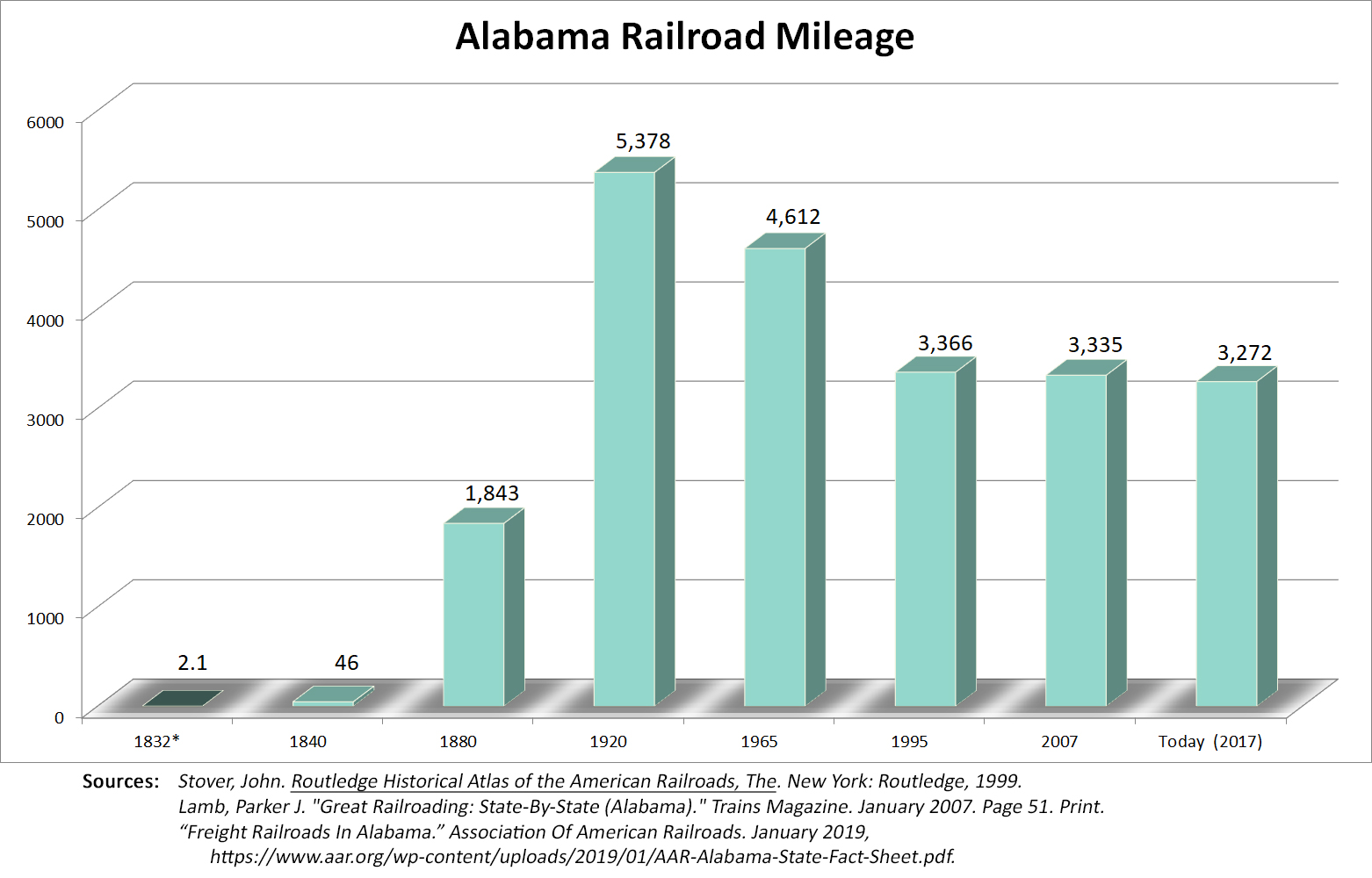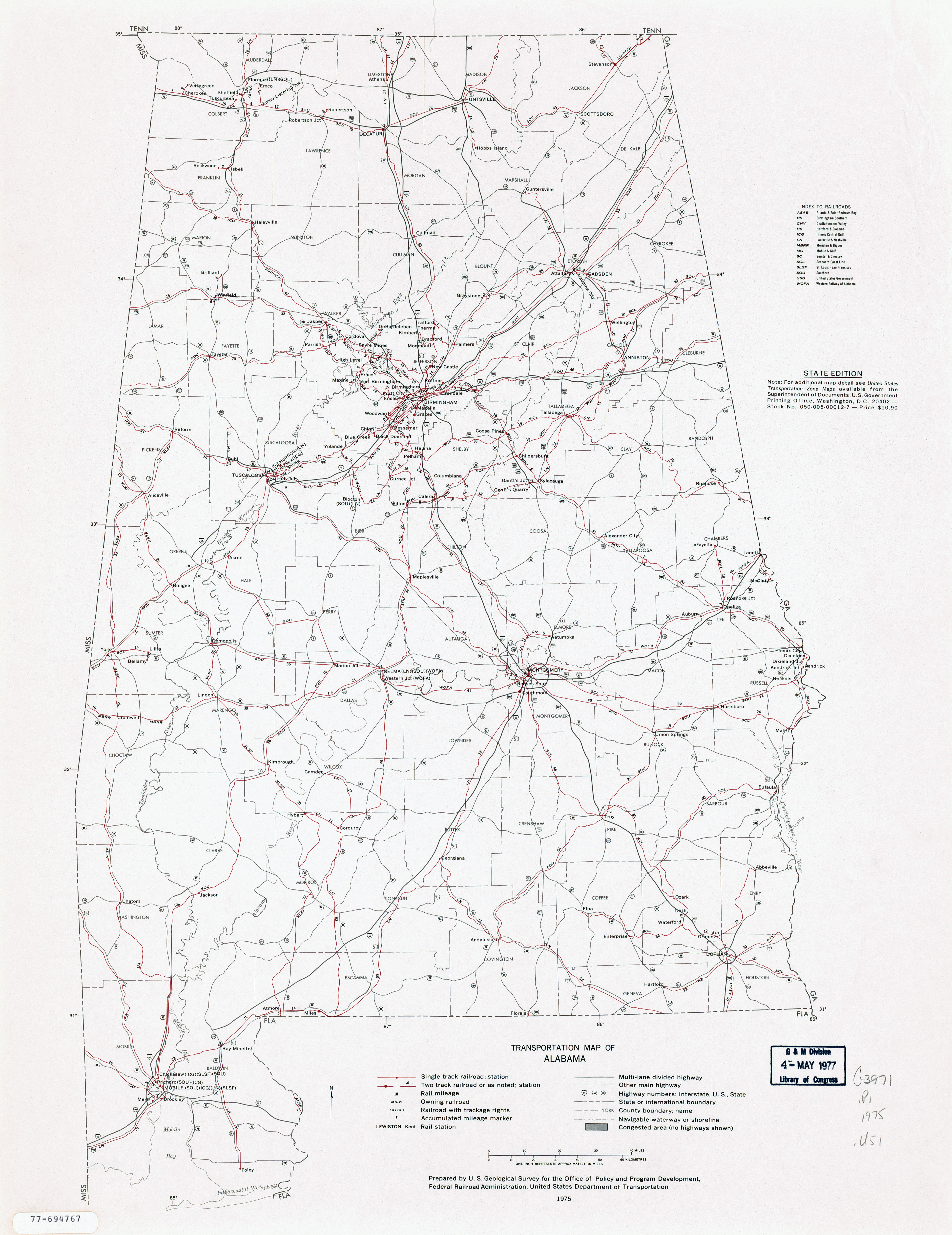- Home ›
- The States ›
- Alabama
Alabama Railroads: Map, History, Abandoned Lines
Last revised: September 7, 2024
By: Adam Burns
auAlabama railroads have been operating since 1832 and the state became an
important source of traffic in later years for railroads with its many
natural resources.
During railroad's "Golden Age" the state was home to well over 5,000 miles of trackage although today that number has been sharply reduced.
Abandonments have sadly a been carried out a grand scale in almost every state in the continental U.S. Alabama has lost over 2,000 miles although its decline has been less severe than many others.
Much of its loss has been via short lines and secondary corridors as the state's main lines remain active.
History
From a railfan perspective the state has an interesting mix of operations from the southern coastal lowlands near the Gulf of Mexico to its northern mountains where one of the state's only tunnels near Carara is located.
Alabama's rail network is, not surprisingly, dominated by the Class I railroads. However, the state is also home to several short lines and one regional to railfan. All of this information, and much more, is listed below.
Also be sure to check out the graph illustrating Alabama's rail mileage throughout the years, including its very first railroad.
Photos
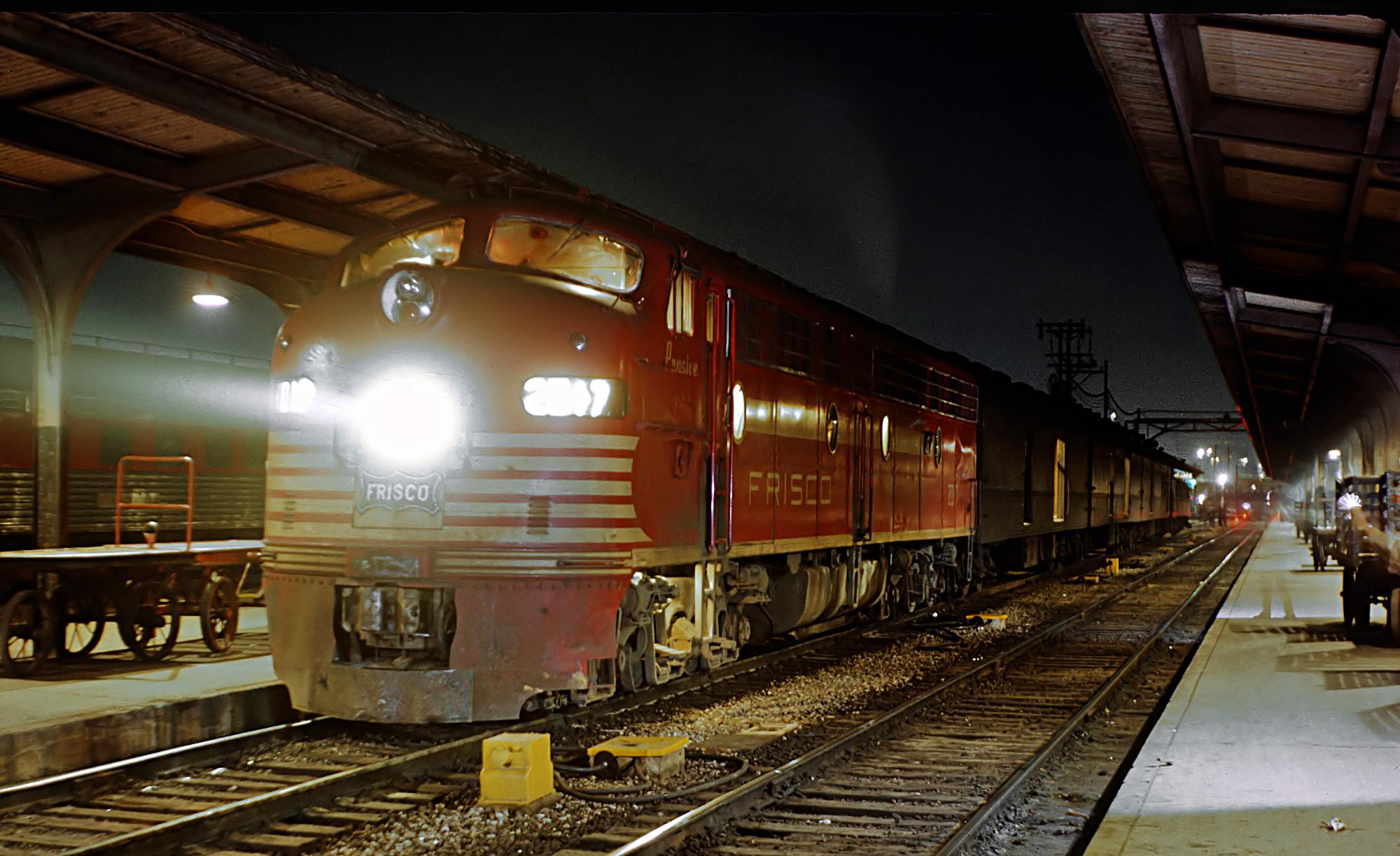 St. Louis-San Francisco's train #108, the "Sunnyland," led by E8A #2017 (the "Pensive," named for the chestnut Thoroughbred that won the 1944 Kentucky Derby and Preakness Stakes), is seen here at Birmingham Union Station on April 15, 1963. Roger Puta photo.
St. Louis-San Francisco's train #108, the "Sunnyland," led by E8A #2017 (the "Pensive," named for the chestnut Thoroughbred that won the 1944 Kentucky Derby and Preakness Stakes), is seen here at Birmingham Union Station on April 15, 1963. Roger Puta photo.The state of Alabama has its beginnings with railroads in 1830 when the little Tuscumbia Railway, originally horse-powered, was chartered on January 16th of that year to connect Tuscumbria with the nearby Tennessee River.
Overall, the little line was just 2.1 miles in length although it successfully served its purpose of moving cotton bales to the river.
The railroad was the fourth incorporated railroad in the country and was the first built west of the Alleghenies. With the success of the line it was reorganized in 1832 as the Tuscumbia, Courtland & Decatur Railroad, connecting its namesake cities just a few years later.
Statistics
The railroad eventually became part of the Memphis & Charleston Railroad, a system that would come under the ownership of the Southern Railway. Interestingly, today, the original TC&D route is still operated by Class I, Norfolk Southern.
Abandoned Lines
The state of Alabama has lost 2,100 miles of railroads since the 1920's; most (1,400 miles) has been removed since only the mid-1960s.
During this era, and through the 1980's, many Class I's were truncating unprofitable branches and secondary corridors while historic short lines were also shutting down.
Every notable railroad to serve the state has shuttered at least a few miles of trackage. One particular standout was the old Alabama, Tennessee & Northern Railroad which became Gulf, Mobile & Ohio's Mobile Division.
This route ran from Aliceville to Mobile and was largely abandoned after the swing bridge over Tombigbee River collapsed in the summer of 1973.
The GM&O elected not to rebuild and the line was subsequently abandoned in stages. Another notable abandonment was the Tennessee, Alabama And Georgia Railway, the "TAG Route."
This small line linked Chattanooga, Tennessee with Gadsden, Alabama. The Southern Railway purchased the TAG in 1971 then began abandoning segments in the 1980's.
If you are interested in doing a little research, check out the state's once extensive logging operations. Not all were common-carrier systems making them difficult to find any information about.
In any event, as Alabama's network became established its natural resources began to be tapped with railroads finding sources of traffic from such things as timber, coal, and iron.
In later years Alabama would be accessed by several classic fallen flag railroads including (the links below provide a brief history of each company):
State Mileage Chart
First Railroad
* Alabama's first operational was the Tuscumbia Railway, a horse-powered system chartered in 1830, the first chartered and opened west of the Appalachian Mountains. It's initial 2.1 miles opened in 1832 to haul cotton bales from downtown Tuscumbria to a new wharf on the Tennessee River. The system was later merged with the connecting Tuscumbia, Courtland & Decatur and eventually wound up as part of the Southern Railway.
In terms of overall mileage, currently Alabama railroad mileage ranks somewhere in the middle of the pack.
During the heyday of the railroad industry Alabama was home to around 5,300 route miles of rails although today that number has dropped by about 48% to slightly over 3,300 miles.
Current Railroads
Today, through mergers, abandonments, and acquisitions Alabama has been reduced to just two Class I railroads, CSX and Norfolk Southern which command 86% of the state's rail mileage although BNSF Railway, Canadian National and Kansas City Southern also have a presence (although their total mileage is less than 400 combined).
However, they are not the only two railroads still operating within the state as there are several short lines found there, including regional Alabama & Gulf Coast Railway.
State Map
The state's railroads, in all, include:
- CSX Transportation
- Norfolk Southern
- BNSF Railway
- Canadian National
- Kansas City Southern
- Alabama & Florida Railway
- Alabama & Gulf Coast Railway
- Birmingham Southern Railroad
- Eastern Alabama Railway
- Huntsville-Madison County Railroad Authority
- Jefferson Warrior Railroad
- Alabama Southern Railroad
- Alabama & Tennessee River Railway
- Alabama Warrior Railway
- Bay Line Railroad
- Birmingham Terminal
- Chattahoochee Bay Railroad
- Conecuh Valley Railroad
- Georgia Southwestern Railroad
- Luxapalila Valley Railroad
- Meridian & Bigbee Railroad
- Redmont Railway
- Mississippi Central Railroad
- Sequatchie Valley Railroad
- RJ Corman/Childersburg Line
- Tennessee Southern Railroad
- Three Notch Railroad
- Wiregrass Central Railroad
- Terminal Railway-Alabama State Docks
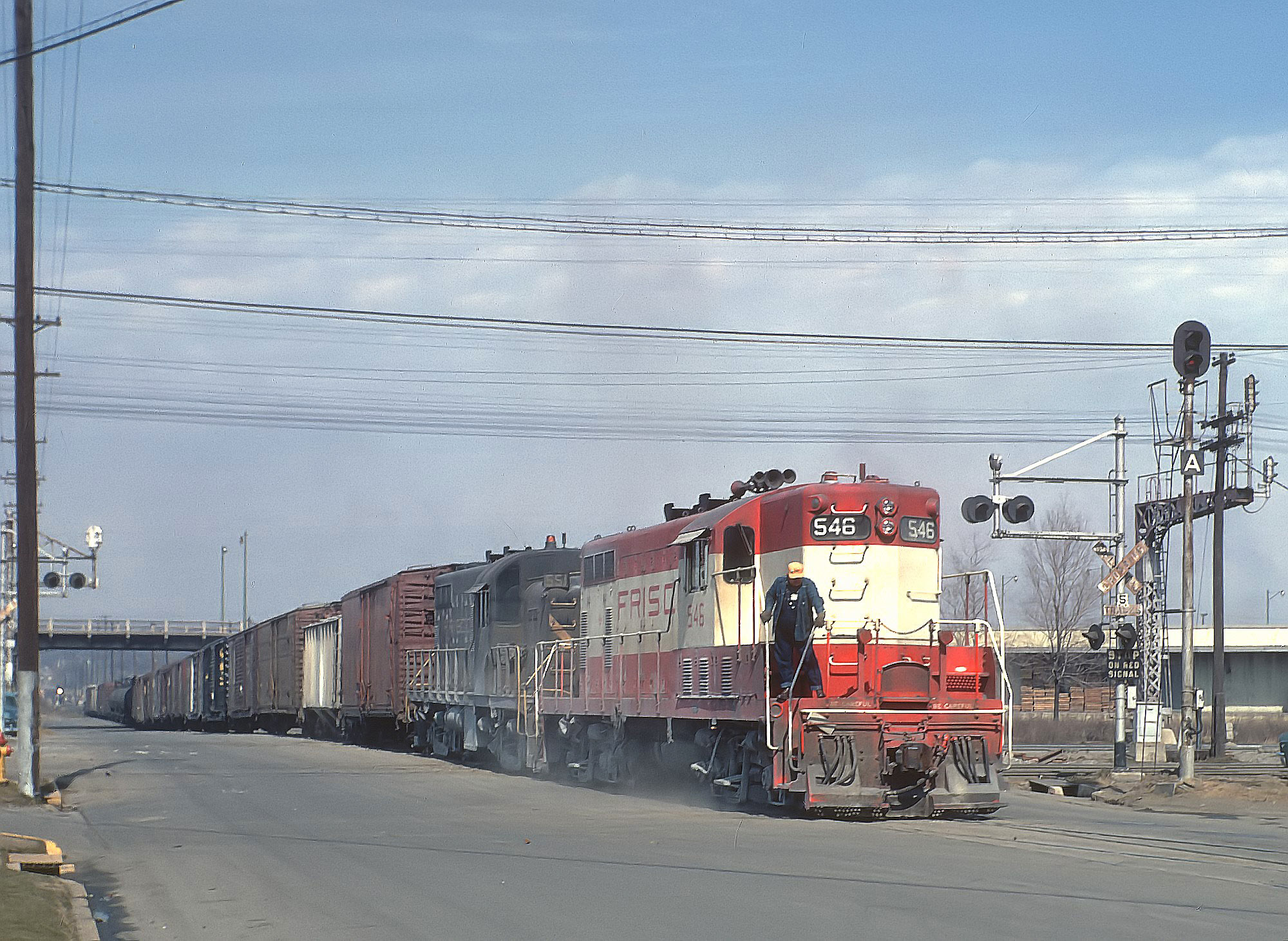 Frisco GP7 #546 and RS2m #551 at 32nd Street and 2nd Avenue in Birmingham, Alabama; February, 1968. Rick Burn photo.
Frisco GP7 #546 and RS2m #551 at 32nd Street and 2nd Avenue in Birmingham, Alabama; February, 1968. Rick Burn photo.Regarding the Class I carriers, major facilities in Alabama can be found in Birmingham - Boyles Yard for CSX, Norris Yard for Norfolk Southern and Thomas Yard for BNSF Railway - as well as another for NS, Sheffield Yard.
While
Alabama railroads do not include many passenger trains, Amtrak does
currently operate one train through the state, the Crescent, which stops at Anniston, Birmingham, and Tuscaloosa along the Norfolk Southern's main line through the state.
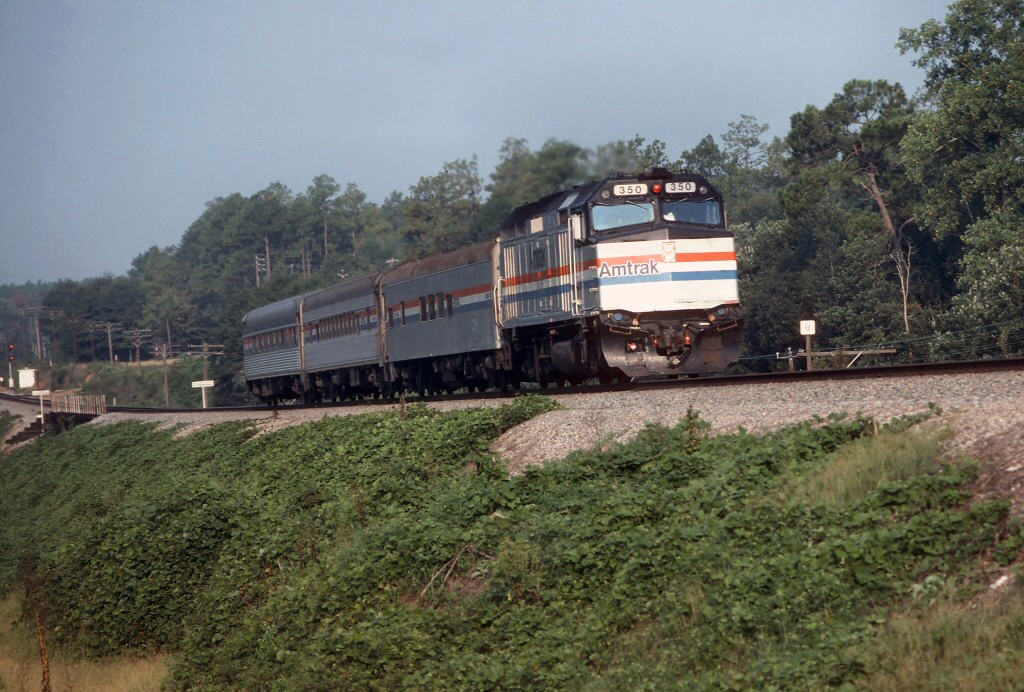 Amtrak F40PH #350 has the northbound "Gulf Breeze" near Atmore, Alabama on the ex-Louisville & Nashville during July of 1990. Gary Morris photo.
Amtrak F40PH #350 has the northbound "Gulf Breeze" near Atmore, Alabama on the ex-Louisville & Nashville during July of 1990. Gary Morris photo.There are also plenty of tourist railroads and museums dotting Alabama.
These include the Foley Museum, Heart of Dixie Railroad Museum, Historic Huntsville Depot, and the North Alabama Railroad Museum. Lastly, Alabama has a few relic stations still standing, Montgomery Union Station and Mobile & Ohio Gulf Terminal in downtown Mobile (for any history, rail, and/or architecture buff these railroad stations are worth the drive to see).
So, if you are interested in either Alabama's railroad history or just looking for something to do you may want to visit one of these places.
Recent Articles
-
Nevada's - Murder Mystery - Dinner Train Rides
Jan 07, 26 02:12 PM
Seamlessly blending the romance of train travel with the allure of a theatrical whodunit, these excursions promise suspense, delight, and an unforgettable journey through Nevada’s heart. -
West Virginia's - Murder Mystery - Dinner Train Rides
Jan 07, 26 02:08 PM
For those looking to combine the allure of a train ride with an engaging whodunit, the murder mystery dinner trains offer a uniquely thrilling experience. -
Kansas's - Murder Mystery - Dinner Train Rides
Jan 07, 26 01:53 PM
Kansas, known for its sprawling wheat fields and rich history, hides a unique gem that promises both intrigue and culinary delight—murder mystery dinner trains. -
Michigan's - Wine Tasting - Train Rides
Jan 07, 26 12:36 PM
In this article, we’ll delve into the world of Michigan’s wine tasting train experiences that cater to both wine connoisseurs and railway aficionados. -
Indiana's - Wine Tasting - Train Rides
Jan 07, 26 12:33 PM
In this article, we'll delve into the experience of wine tasting trains in Indiana, exploring their routes, services, and the rising popularity of this unique adventure. -
South Dakota's - Wine Tasting - Train Rides
Jan 07, 26 12:30 PM
For wine enthusiasts and adventurers alike, South Dakota introduces a novel way to experience its local viticulture: wine tasting aboard the Black Hills Central Railroad. -
Kentucky Thomas The Train Rides
Jan 07, 26 12:26 PM
If you’ve got a Thomas fan in the house, Day Out With Thomas at the Kentucky Railway Museum is one of those “circle it on the calendar” weekends. -
Michigan's Thomas The Train Rides
Jan 07, 26 12:10 PM
If you’ve got a Thomas fan in the house, few spring outings feel as “storybook-real” as Day Out With Thomas™ at Greenfield Village in Dearborn, Michigan. -
Texas Dinner Train Rides On The TSR!
Jan 07, 26 11:36 AM
Today, TSR markets itself as a round-trip, four-hour, 25-mile journey between Palestine and Rusk—an easy day trip (or date-night centerpiece) with just the right amount of history baked in. -
Iowa Dinner Train Rides In Boone!
Jan 07, 26 11:06 AM
If you’ve ever wished you could pair a leisurely rail journey with a proper sit-down meal—white tablecloths, big windows, and countryside rolling by—the Boone & Scenic Valley Railroad & Museum in Boon… -
Wisconsin Dinner Train Rides In North Freedom!
Jan 06, 26 10:18 PM
Featured here is a practical guide to Mid-Continent’s dining train concept—what the experience is like, the kinds of menus the museum has offered, and what to expect when you book. -
Pennsylvania Dinner Train Rides In Boyertown!
Jan 06, 26 06:48 PM
With beautifully restored vintage equipment, carefully curated menus, and theatrical storytelling woven into each trip, the Colebrookdale Railroad offers far more than a simple meal on rails. -
North Carolina ~ Murder Mystery ~ Dinner Train Ride
Jan 06, 26 11:26 AM
While there are currently no murder mystery dinner trains in the Tarheel State the Burgaw Depot does host a murder mystery dinner experience in September! -
Florida's - Murder Mystery - Dinner Train Rides
Jan 06, 26 11:23 AM
Florida, known for its vibrant culture, dazzling beaches, and thrilling theme parks, also offers a unique blend of mystery and fine dining aboard its murder mystery dinner trains. -
New Mexico's - Wine Tasting - Train Rides
Jan 06, 26 11:19 AM
For oenophiles and adventure seekers alike, wine tasting train rides in New Mexico provide a unique opportunity to explore the region's vineyards in comfort and style. -
Ohio's - Wine Tasting - Train Rides
Jan 06, 26 11:14 AM
Among the intriguing ways to experience Ohio's splendor is aboard the wine tasting trains that journey through some of Ohio's most picturesque vineyards and wineries. -
Connecticut's Thomas The Train Rides
Jan 06, 26 11:06 AM
For 2026, the tour stop at Essex brings Thomas (and Percy, too) to the historic Valley Railroad for a full day of events for the kids. -
Maryland's Thomas The Train Rides
Jan 06, 26 11:00 AM
In 2026, the B&O Railroad Museum in Baltimore welcomes the Let’s Rock, Let’s Roll Tour with four event days that combine a Thomas-themed excursion with other activities. -
Tennessee's Thomas The Train Rides
Jan 06, 26 10:51 AM
Set on the grounds of one of the Southeast’s best-known operating railroad museums, the Thomas the train event blends kid-friendly fun with the unmistakable sights, sounds, and atmosphere of a real wo… -
Georgia's Thomas The Train Rides
Jan 06, 26 10:44 AM
Day Out With Thomas is set to roll back into Cordele in 2026, bringing Thomas the Tank Engine and a full family festival to the SAM Shortline at Georgia Veterans Memorial State Park.

